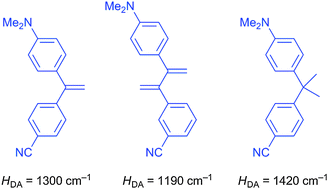Photoinduced charge transport over branched conjugation pathways: donor–acceptor substituted 1,1-diphenylethene and 2,3-diphenylbutadiene
Abstract
Photoinduced charge transport in

* Corresponding authors
a Flinders Centre for Nanoscale Science and Technology, School of Chemical and Physical Sciences, Flinders University, GPO Box 2100, Adelaide 5001, Australia
b
Department of Chemistry, Utrecht University, Sorbonnelaan 16, Utrecht, 3584 CA, The Netherlands
E-mail:
c.a.vanwalree@uu.nl
c BELECTRIC OPV GmbH, Landgrabenstrasse 94, Nürnberg, Germany
d Molecular Photonics Group, Van ‘t Hoff Institute of Molecular Sciences, University of Amsterdam, Science Park 904, 1090 GD Amsterdam, The Netherlands
Photoinduced charge transport in

 Please wait while we load your content...
Something went wrong. Try again?
Please wait while we load your content...
Something went wrong. Try again?
C. A. van Walree, B. C. van der Wiel and R. M. Williams, Phys. Chem. Chem. Phys., 2013, 15, 15234 DOI: 10.1039/C3CP52148F
This article is licensed under a Creative Commons Attribution-NonCommercial 3.0 Unported Licence. You can use material from this article in other publications, without requesting further permission from the RSC, provided that the correct acknowledgement is given and it is not used for commercial purposes.
To request permission to reproduce material from this article in a commercial publication, please go to the Copyright Clearance Center request page.
If you are an author contributing to an RSC publication, you do not need to request permission provided correct acknowledgement is given.
If you are the author of this article, you do not need to request permission to reproduce figures and diagrams provided correct acknowledgement is given. If you want to reproduce the whole article in a third-party commercial publication (excluding your thesis/dissertation for which permission is not required) please go to the Copyright Clearance Center request page.
Read more about how to correctly acknowledge RSC content.
 Fetching data from CrossRef.
Fetching data from CrossRef.
This may take some time to load.
Loading related content
